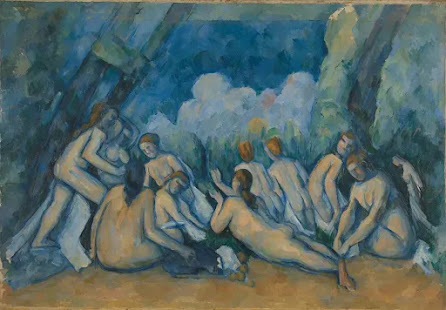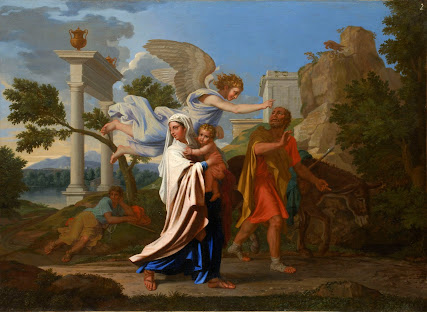Johannes Vermeer 1632-1675
oil on canvas - 98 x 105 cm
Mauritshuis,The Hague
Johannes Vermeer painted Diana and Her Nymphs around 1653-1654, just after joining the painters’ guild in Delft. The scene emanates a salutary atmosphere of tranquillity. Five women have gathered in a clearing in the woods, each one absorbed in her own thoughts. Diana is seated in the centre, recognisable by her standard attribute of a crescent moon on her head. The kneeling woman is solicitously washing Diana’s feet, watched by the dog on the left. The woman in the red blouse beside Diana is rubbing her foot. The woman who is standing, dressed in black, gazes at the ground. The fifth woman, on the left, has her back to us. Although the subject matter, the large figures filling the picture plane, and the warm colouring of this painting all differ from Vermeer’s later interiors, its subdued, dreamy atmosphere does strike a similar chord.
In classical mythology, Diana is a daughter of Jupiter and Leto and Apollo’s twin sister. She is the virginal and youthful moon goddess and the goddess of hunting. She is usually depicted in the open countryside, accompanied by her devoted nymphs. Painters would often depict the story about the huntsman Actaeon, who unintentionally comes upon Diana and her nymphs while bathing. To punish him for looking at her she changes him into a stag, after which his own dogs kill him. Another popular tale focuses on the discovery that one of Diana’s nymphs, Callisto, is pregnant (by Jupiter). The chaste Diana punishes the pregnant nymph by turning her into a bear. We do not encounter any such violent, emotional scenes in Vermeer. The women depicted here are taking a moment’s repose.
There has been much speculation about why the young Vermeer, whose fame today rests on his interior scenes, should have begun his career by painting a number of history pieces. The answer may perhaps be found in seventeenth-century handbooks on art, which always discuss history pieces with especial esteem. Before painting a history piece – whether it represented a story from classical mythology, the Bible, or history – the artist had to read the story, choose a particular episode to depict, devise a good composition, and finally render the events with all due decorum. In other words, he would have to give a great deal of thought to his work before picking up the paintbrush.
The picture’s intimate character is heightened by the dark, enclosing background. That this was the artist’s intention did not become clear until the most recent conservation treatment of the painting in 1999–2000. Until that time, blue sky and clouds filled the upper right section of the canvas. Technical research has shown that this sky could not have been original, since the paint was found to contain the pigments Prussian blue and chrome green, which were not available in Vermeer’s day. It must therefore be a later overpainting. It was decided to reconstruct the original state by covering the blue sky with a thin, neutral overpainting in a dark brow tone in keeping with the rest of the background. Now that the sky at the upper right is obscured, the light falling onto the figures from the left gains in importance, clearly revealing how Vermeer played with light and colour. It was also discovered that the canvas had been cropped approximately 12 centimetres on the right hand side. The woman kneeling at the lower right must have appeared fully in the picture, making the composition more balanced and placing the focus on Diana’s foot-washing.
Diana and Her Nymphs was purchased at a Paris sale on 4 May 1876 for the relatively modest price of 10,000 French francs. The painting was attributed at the time to Nicolaes Maes, a pupil of Rembrandt’s. During restoration work in 1885 it was discovered that the monogram of Nicolaes Maes, ‘N.M.’, was a forgery, and that the signature ‘J VMeer’ lay underneath it.
(this is a reworked version of a text published in in: P. van der Ploeg, Q. Buvelot, Royal Picture Gallery Mauritshuis: A princely collection, The Hague 2005)



.jpg)
